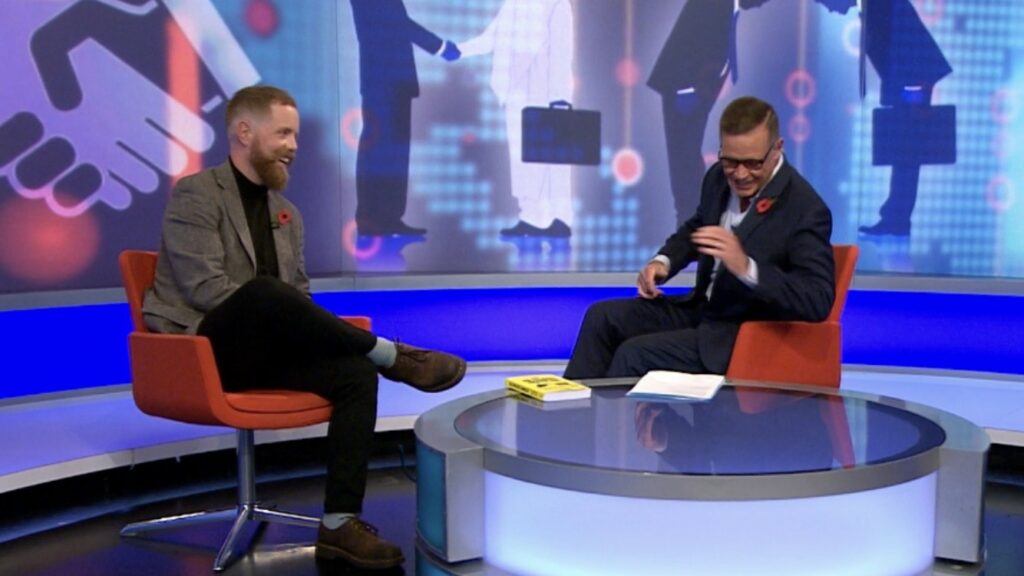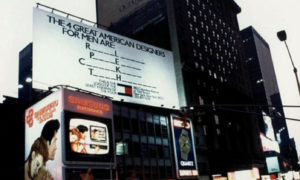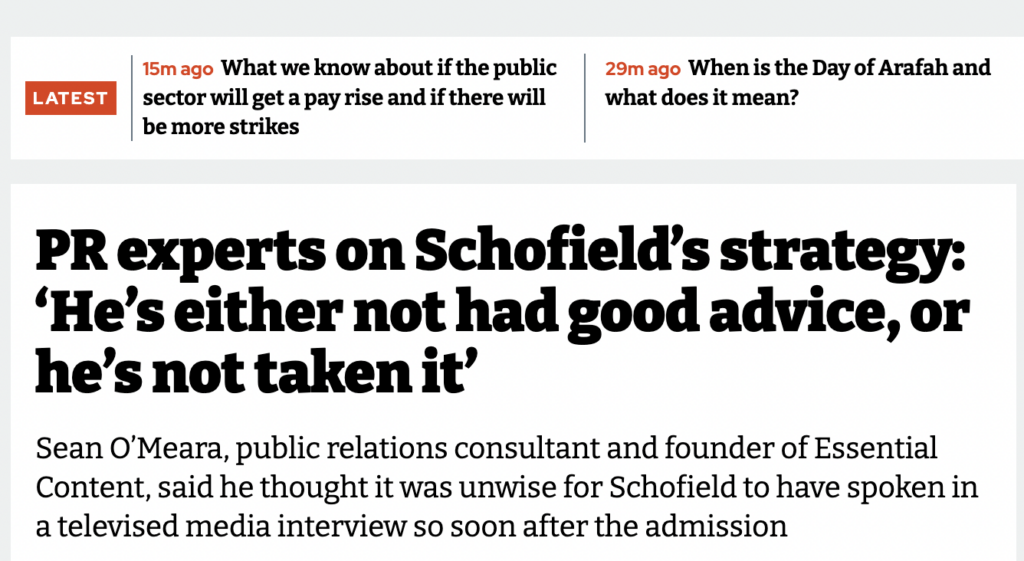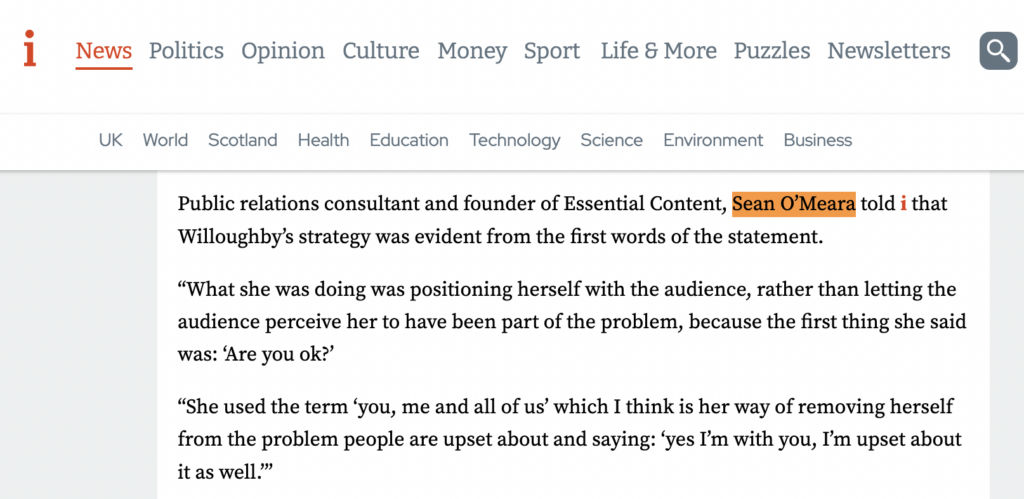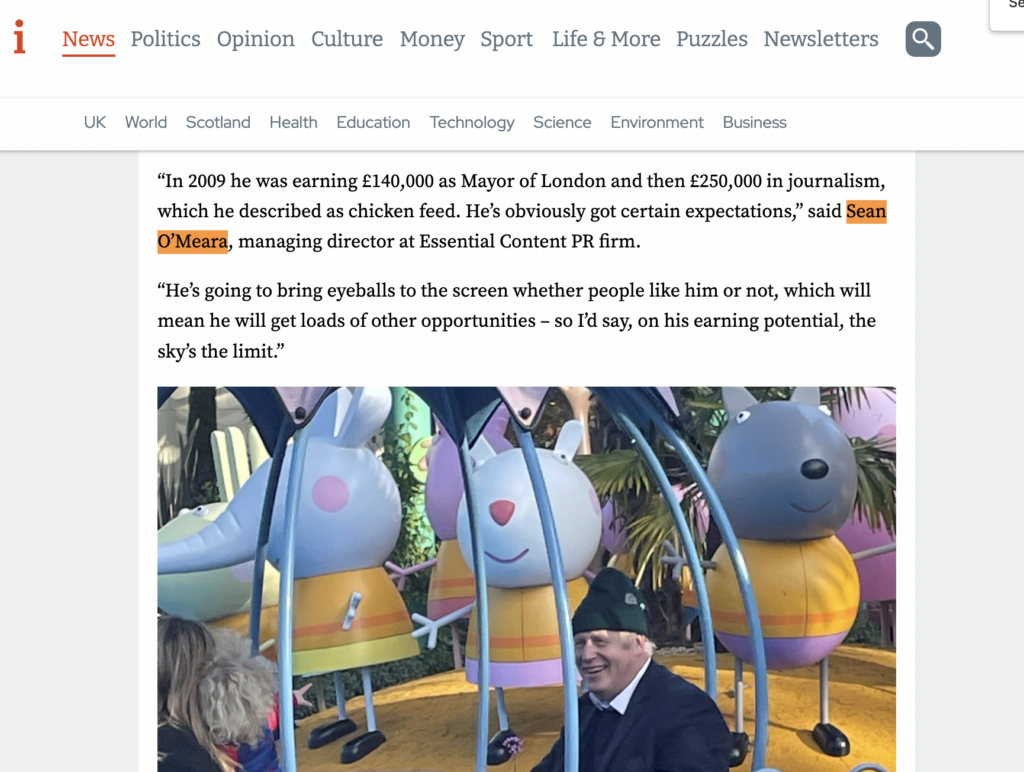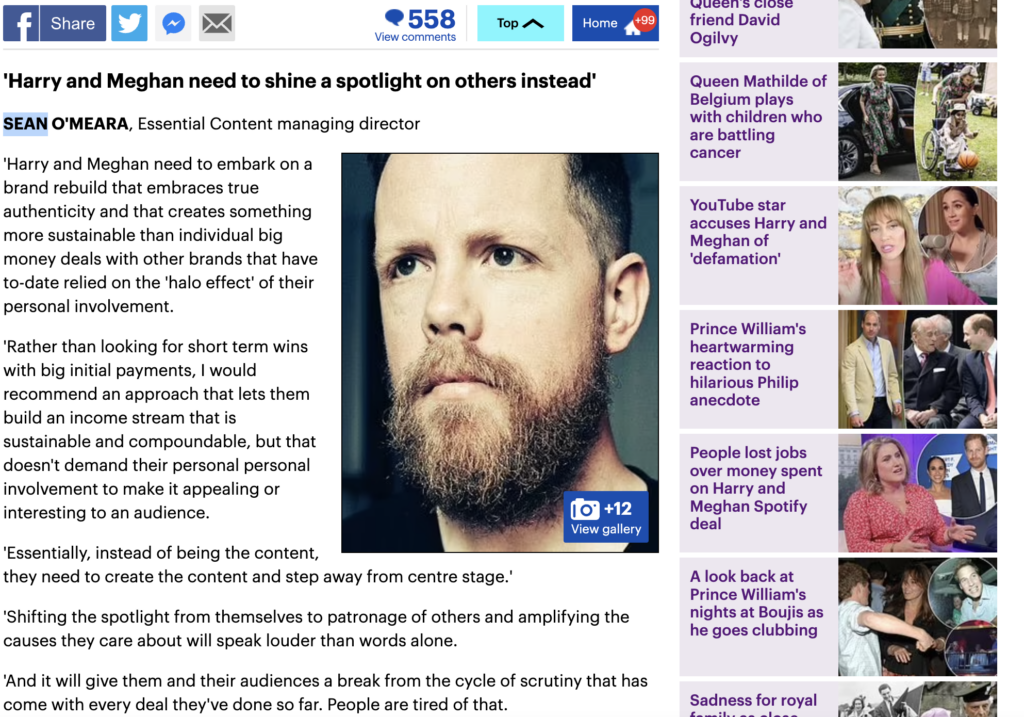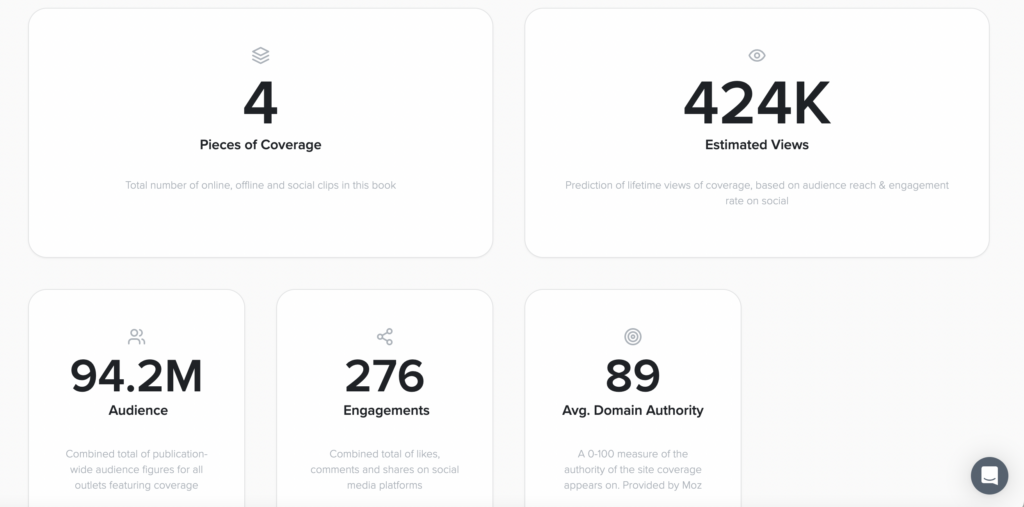What is reactive PR? How Essential Content earned millions of impressions through 2 hours work
There are loads of ways to do public relations, but in our experience, PR activity tends to fall into one of the following 3 categories.
- Proactive PR
- Reactive PR
- Crisis communications and issues management (this is technically a type of reactive PR)
To understand reactive PR, we need to establish how it differs from proactive PR. The characteristics of proactive PR include the following:
- Planned content with agreed messaging.
- Scheduled activation. Proactive PR is typically planned weeks or months in advance and is often pegged to an event, either in the client’s roadmap or to something that’s happening in the world (like Christmas, The World Cup, the budget and so on.)
- Controlled messaging. Proactive PR is about sharing a specific, strategic message with a specific, targeted audience.
- Outbound media relations. By definition, proactive PR involves outbound media relations, also known as pitching or selling-in.
Reactive PR works differently. The main difference between proactive and reactive PR is in the planning and scheduled activation. By necessity, being reactive means that your comms leaders and delivery team are working somewhat by the seat of their pants. Reactive public relations campaigns typically include the following characteristics.
- Unplanned. They’re not always unplanned, but most of the time at the very least there is significantly less planning time and roadmapping.
- Unscheduled activation. In many cases, reactive PR opportunities come in response to an event or emerging trend.
- Controlled messaging. This is one of the few similarities between proactive and reactive PR. In both instances, you should have a degree of control over the messaging. This isn’t true for crisis communications and issues management, but it is broadly true and indeed an objective of both reactive and proactive PR.
- Outbound media relations. This is another similarity. Reactive PR can involve a degree of outbound media relations activity, but…
- Inbound media relations. This is a key difference. It’s rare (and often very exciting) for publicists who deal with inbound media enquiries. The one big caveat here is that the excitement often turns to anxiety if you’re dealing with a crisis comms scenario.
Reactive PR in a nutshell
Reactive PR is the sort of public relations activity that can only happen in response to something else that has happened. Some types of reactive PR include:
- Expert analysis. You’ll see this a lot when certain stories hit the news and the news media needs experts to help their audiences understand it. These sort of scenarios typically see company or brand spokespeople speaking to the media, either on TV, radio or in ‘print’, giving their thoughts and insights.An example might include the head of data security from a technology provider talking to the news about a recent hack, or someone from a bank talking about interest rates.
Here’s Sean O’Meara, managing director of Essential Content talking to BBC business journalist Aaron Heslehurst on the show Talking Business. This was a reactive PR opportunity for Sean, as it came about in response to a trend of high profile brands issuing poorly worded apologies.
- Data or trend analysis. This is similar, but it can often be branded rather than from a specific person. Most often, this sort of PR comes in the form of data or trend analysis done on behalf of a company. For example, we see a lot of great PR where a trend is emerging and a brand responds to it with its own research, either earnestly or even in jest.One of our favourite examples of was the Showcase Cinema campaign ‘Readheads go free’. This campaign was a reaction to the summer heatwave in the UK in 2022. The cinema chain offered readheads free tickets and in return, the brand was able to talk about the fact that they have really good air conditioning in their theatres.
How is reactive public relations different from newsjacking?
Lots of agencies and practitioners treat ‘newskacking’ as a type of reactive PR. We agree that it is reactive in its nature, but we treat it as a separate type of PR. Here’s why.
Newsjacking is about pegging a brand or product to an event or trend that is emerging.
One of the best-known examples was when the Oreo Cookie Twitter account responded to a power cut at the Super Bowl in 2011. It was clever, quick and quite funny. Search Engine Journal has written a great article about newsjacking that includes a mini case study on Oreo.
Newsjacking campaigns typically feature the following characteristics.
- Low effort
- Brand-centric
- Memorable
- Delivered ‘in the moment’
- Opportunistic
- Publicity for publicity’s sake
The reason we differentiate newsjacking from other forms of reactive PR is that the value to the brand is different. Newsjacking is great for reminding people you’re here, but it’s not necessarily great for communicating in depth or amplifying expertise or values. In a nutshell, newsjacking ‘in the moment’ makes a brand part of a story that’s already happening. Other types of reactive PR are sufficiently distanced from the ‘moment’ that the brands and spokespeople involved are viewed through the prism of expertise.
Why is reactive PR effective?
Reactive PR is effective for a number of reasons.
The ‘cheerleader effect’
If you’re not familiar with the cheerleader effect, here’s a quick explainer: A study found that people were rated higher for attractiveness when surrounded by other attractive people compared to when they were viewed on their own. The presence of other attractive people has the effect of ‘averaging out’ the attractiveness of a group. Or to put it more crudely; if you’re normally a 7/10 on the attractiveness scale, you might get bumped up to an 8/10 if you’re surrounded by solid 10s.
The same logic applies with public relations.
Sometimes sharing media coverage with ‘competitors’ is more powerful than having it all to yourself. Especially if they’re ‘attractive’.
If you share the column inches with people and brands that people already know and respect, you get to bask in a bit of their reflected glory. People assume it’s reasonable for you to be mentioned in the same breath as them. Especially if it happens more than once.
So for Essential Content, being included in the same feature as people like Mark Borkowski and Farzana Baduel (Curzon) is a powerful thing. Especially for a small but growing agency like ours.
Legendary ad man George Lois knew this too.
When he launched Tommy Hilfiger in NYC in 1985, he used his client’s small budget to promote other brands.
In 1985, nobody had heard of Tommy Hilfiger, so instead of going big and trying to get as much ‘share of voice’ that their budgets would permit, George Lois devised a billboard campaign where his client shared the limelight, celebrating ‘4 great American designers’. He put Hilfiger in the same frame of reference as Ralph Lauren, Perry Ellis and Calvin Klein.
For brands and public figures who invest in PR, when it comes to media coverage, the cheerleader effect can be very powerful and sometimes less is more.
Compounding benefits
Doing reactive PR has compounding benefits. When you do it once, and do it well, journalists start to notice you. And not only do they notice you, they perceive you as a useful and reliable media commentator, because you’re in the media reacting to a story. There are lots of experts with interesting perspectives who could all add immense value to a news story, but journalists are a cautious bunch and tend to focus on contributors that they strongly believe will meet the following criteria.
- Reliable – can you be reached and will you respond quickly?
- Knowledgeable – do you know your topic well enough?
- Available – are you free now (for ten minutes)?
- Concise – can you say what needs to be said in a printable soundbite?
- Quotable – is what you’re about to say going to add colour, intrigue or a new perspective to the story?
- Unique – are you going to be echoing what everyone else is saying? Or are you going to give the journalist something they’ll want to put at the top of their piece?
If you’re in the media giving your expert insights, and you do it well once, don’t be surprised if another journalist contacts you to do the same for them.
Expert status unlocked
The most important benefit of doing reactive PR is that it positions you as a subject matter expert. As far as your customers and potential customers are concerned, why else would the media be coming to you? They certainly don’t know that the media comes to you not just for your expertise, but because you’re reliable, available and quotable. There’s a reason we often see the same experts commenting on news stories. There are lots of other experts, but they’re not all primed and ready (or interested) to give their quotable, unique insights.
Reactive PR case study
To put the above theories to the test, the team at Essential Content decided to take its own medicine. Why would you trust a public relations agency that can talk the talk about reactive PR without being to deliver it for their own firm.
So, we waited for an opportunity to come along. And it didn’t take long.
On June 2nd 2023, we noticed that Ellen O’Dwyer, a reporter for the Independent was looking for public relations experts to comment on story about Philip Schofield sacking story. It didn’t initially feel exactly in our wheelhouse, but we did some research and prepared some content. Then we got a stroke of luck. An agency with whom we partner said that Ellen had contacted them, and they’d suggested us as suitable contributors.
So our managing director Sean got in touch with Ellen and we had a chat. The important thing to remember here is that we’d prepared a selection of talking points.
The results were immediate and very positive. In fact, at the very top of the article, and in all of the associated social media posts, Sean was referred to as a PR expert.
So Sean got his name in the Independent and was quoted as an expert. So what?
Good point. This coverage didn’t bring in any enquiries to Essential Content and we didn’t expect it to.
So the benefit lies entirely in the perception of Sean as a “PR expert” and the mention of Essential Content. There are associated SEO benefits here too which we won’t go into in this post.
What happened next?
A few days later, Ellen got in touch again seeking comment about a related story involving Schofield’s former co-host, Hollie Willoughby. Again Sean was quoted as an expert.
So that’s two articles within a week, with same the outlet and the same reporter.
What next?
A few weeks later, we were contacted again. This time by a different reporter at the Independent. She was asking if we could contribute to a piece about former Prime Minister Boris Johnson. So again, we prepared some quotable, unique content and had a chat.
The result was another media hit in the Independent. This time the cheerleader effect really kicked in, as Sean was quoted alongside the likes of Mark Borkowski and Farzana Baduel, two well recognised PR leaders, elevating perceptions of Sean.
We asked Ruth, the journalist why she got in touch and she said she’d asked around the newsroom if anyone knew any PR experts, and Ellen had recommended Sean, because he’d been responsive, available and quotable.
So that’s three media hits in one outlet, what next?
A week or so after the third Independent piece, the Daily Mail got in touch.
We didn’t have a relationship with this reporter. This was now approaching ‘rent-a-gob’ levels of media exposure, but we went with it.
Here’s the article, complete with brand mention and photo.
Conclusion
As you can see from the metrics, the return on time investment here is huge. Reactive PR, when done right, will do the following things very quickly.
- Establish subject matter expert status for your spokesperson
- Compound coverage and supercharge brand awareness
- Get your spokesperson added to journalist databases of ‘go to’ contributors
- Build trust with your audience
- Boost your ego (let’s be honest here)
Compared to proactive PR, this was significantly less effort for significantly more coverage. We’ve spent literally days on proactive campaign outreach and earned a significantly smaller share of voice than this activity gleaned for us.
The total amount of time dedicated to securing this coverage was less than 2 hours. That includes speaking to journalists, clarifying via email, and preparing commentary. Approximately 75% of that time was the latter.
According to Coveragebook metrics, 424,000 people read the content that Sean contributed to. And it had a total of 89 engagements.
Here are a few other metrics worth considering.
- Total outreach time – 0 hours
- Total press release writing time – 0 hours
- Total media list production time – 0 hours
So why not ditch proactive PR and focus 100% of effort on reactive PR?
Why not ditch food and focus 100% of your intake on vitamin supplements and coffee?
Reactive PR can give you a short term boost, sometimes in the time it takes to brew a cup of coffee. But the boost wears off and you need real sustenance. That’s where your proactive campaigns earn their keep.
The beauty of reactive PR is that you don’t need to invest the same amount of resource into securing coverage as you do for proactive campaigns.
PR can’t live on a diet of just reactive coverage. That’s like living on a diet of just double espresso coffee. A quick hit, delivered in a small dose that packs a punch is great once in a while, but you need other stuff going on in the mix too.
How do I use reactive public relations for my brand or business?
Here’s one quick and free way to start leveraging reactive PR for your brand or business today.
- Start monitoring the #journorequest feed on Twitter. This is where reporters solicit quick contributions for short and medium deadline articles. Be warned, there’s a LOT of rubbish on there. Get used to muting accounts that use the feed for blagging free stuff. But stick with it.
- Be useful. If you’re going to contact a journalist, please make sure that you’re not just trying to plug your company. Think deeply about the value you can add.
- Be available. They may wish to interview you or clarify some points via email. Don’t respond if you’re about to go into a 2-hour meeting or on holiday.
- Be different. Look carefully at the request and try to figure out a way to come at it from a new perspective. The journalist you are talking to will be speaking to other contributors too, and he or she will no doubt have to cut some of them out. Lower your chances of being spiked by offering a unique, or at least novel, perspective.
- Be friendly. This is under-rated. If you get the coverage, make sure to follow up with a thank you and do let them know you’re happy to talk about other things to. Provide a list of the topics where you can genuinely add value.
Interested in learning more about how reactive PR can help your business?
Why not get touch today for an informal 15-minute chat?
